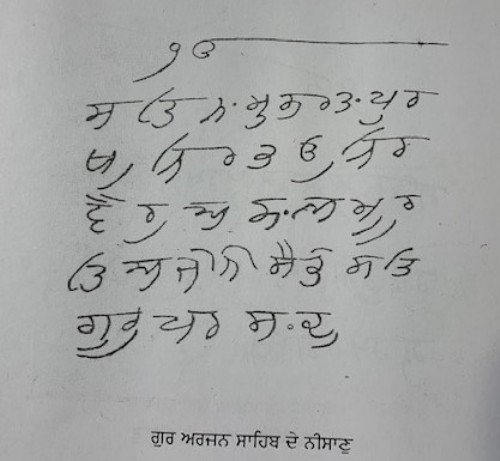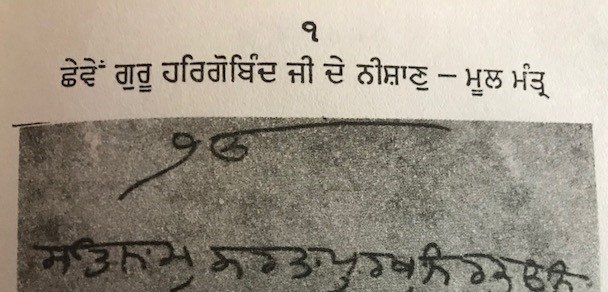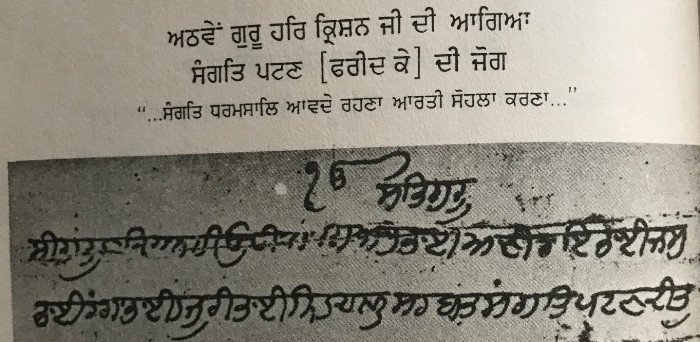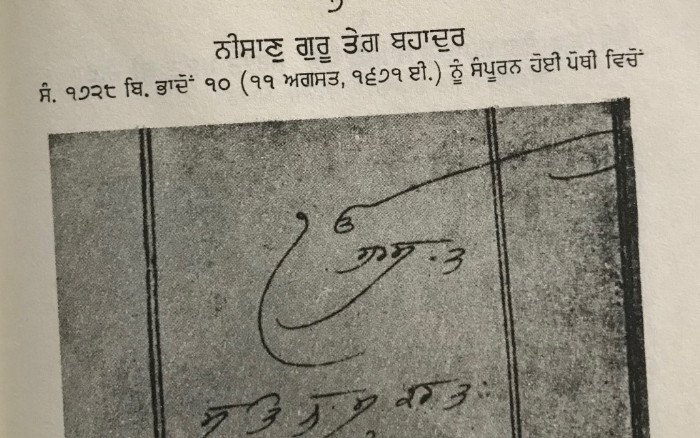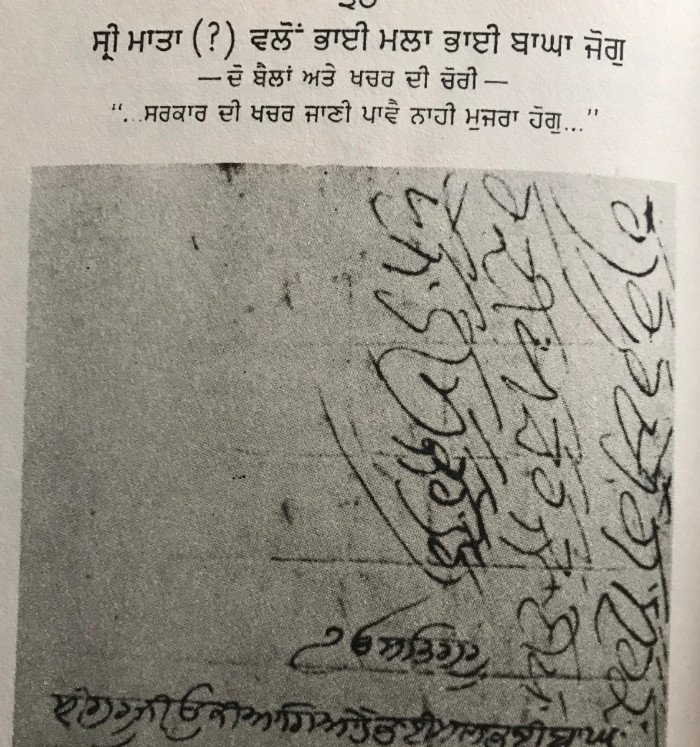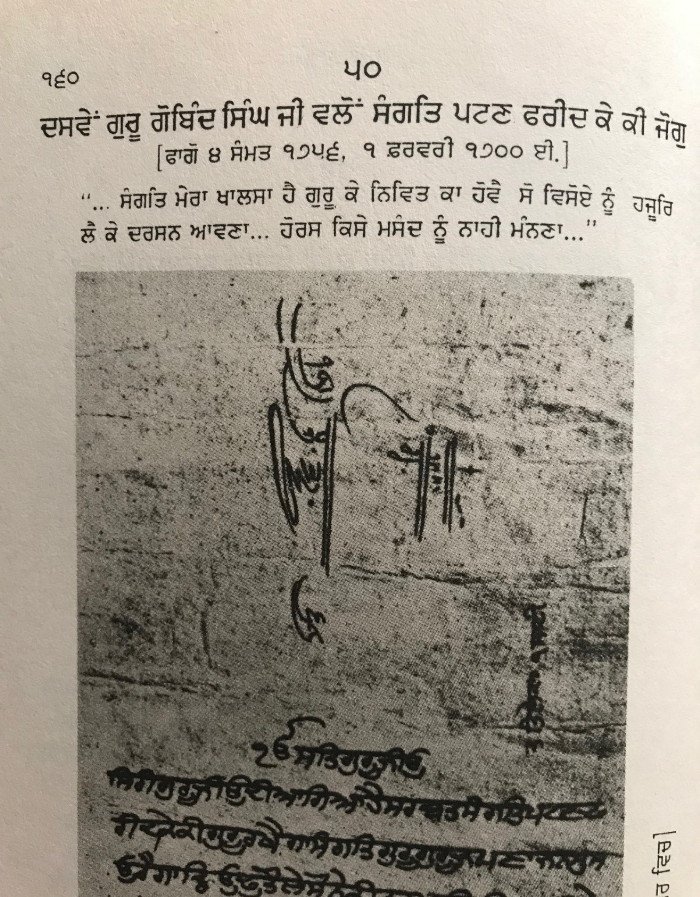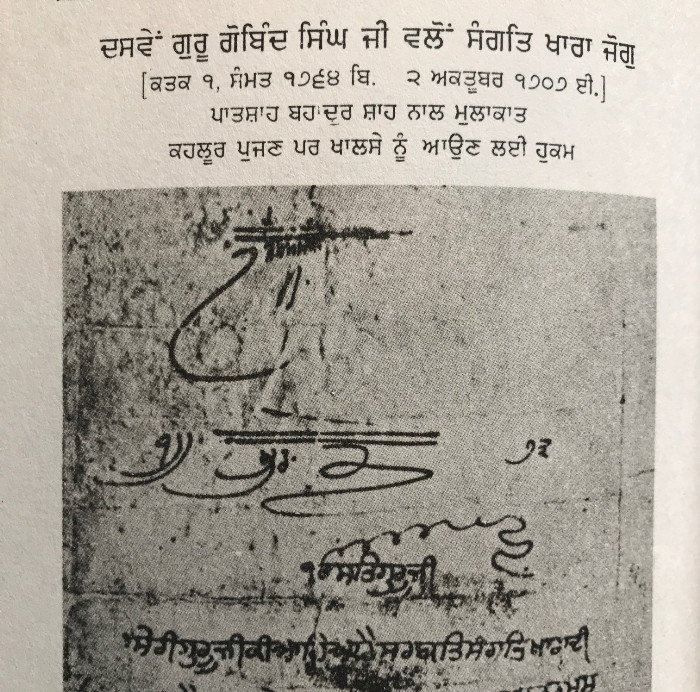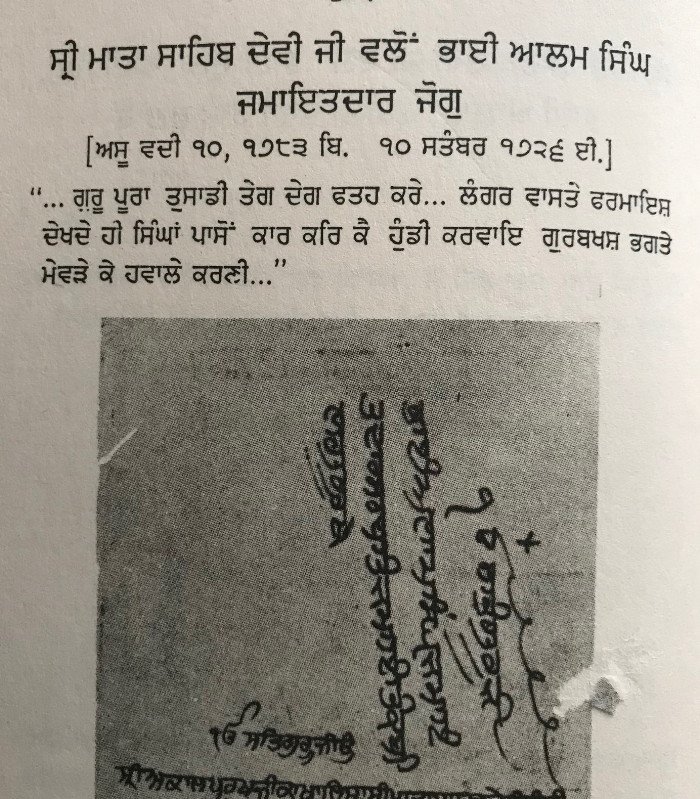ੴ
EikkAo, The Proper Pronunciation
Gulbarg Singh Basi
[email protected]
ੴ, is the very first and only symbol / word written in the very first line of handwritten copies of the Guru Granth Sahib (SGGS) e.g. ਕਰਤਾਰ ਪੁਰ ਵਾਲੀ ਬੀੜ = krtaar pur vaali beerh. It is also written as the first word on most handwritten hukm naamay of Guru Sahibs as compiled by Prof. Ganda Singh in his book ਹੁਕਮ ਨਾਂਮੇ = hukm naamay (Orders).
This article aims to address the pronunciation of ੴ symbol. The explanation is divided into the following seven sections.
- What got me started.
- Why traditional pronunciation doesn’t make sense.
- Logical approach to pronunciation of ੴ as written.
- What does this pronunciation mean?
- Some quotes from Gurbani where ਇੱਕੋ = EikkAo (The One, The Unity), is used to refer to ੴ.
- Why I think the others suggested pronunciations are not logical.
- Conclusion.
1. What got me started:
ੴ , wherever I have heard, has always been pronounced as ਇੱਕ ਓਅੰਕਾਰ = Eikk Aoankaar, and in English, usually spelled as IKK OANKAR. It was during one of the TV shows that it had been spelled, in English, as IKK OMKAR which gave me the feeling that someone is trying to give Sikhi, a Vedic twist. That one event raised a question in my mind and I wanted to know the correct pronunciation of this symbol / word, ੴ. Not only the correct pronunciation, but also the message behind this Symbol / word, ੴ, intended by Guru Nanak and not its Vedic interpretation.
In the meantime, I got introduced to an article by Dr. Devinder Singh Chahal of Institute of Understanding Sikhi, Montreal, Canada, asserting its pronunciation to be ਇੱਕ ਓਹ ਬੇਅੰਤ = Ikk Oh Beant (The Infinite One). Then I heard a presentation from S. Gurbans Singh of Ludhiana, Punjab, where he asserted that proper pronunciation of ੴ is ਏਕੰਕਾਰ = EaykNkaar, as per Gurbani enshrined in Guru Granth Sahib. S. Manmohan Singh Scout of Mohali, Punjab, has been equal participant in sharing that the ਏਕੰਕਾਰ = EaykNkaar, is the proper pronunciation for ੴ.
As a result of my research I wrote a short article earlier in 2016 and claimed as best as I could make out the word ੴ should be pronounced as ਇੱਕੋ = EikkAo (The One, Unity of the Source and the Creation).
I had received many a positive comment, most supporting my thought and some also having a bit different perspective. At the same time, I was also informed that I am not the first one to make this claim, a few other Sikhi Scholars have already asserted. that ੴ should be pronounced as EikkAo = ਇੱਕੋ (The One, Unity of the Source and the Creation).
This article is adding a few more details to the earlier article and the text is rearranged to enhance the flow of thought.
2. Why traditional pronunciation doesn’t make sense to me:
Traditionally ੴ is pronounced as ਇੱਕ ਓਅੰਕਾਰ = Eikk AoANkaar. The majority of Sikhs know it as such. This pronunciation is derived from breaking down the symbol into three parts and each part pronounced separately. To make the pronunciation to be ਇੱਕ ਓਅੰ ਕਾਰ = Eikk AoAN kaar.
Professor Sahib Singh, among them, explains it as:
The symbol/word ੴ consists of following three parts:
- ੧ = ਇੱਕ = Eikk
- ਓ = ਓਅੰ = AoAN
- > = ਕਾਰ = kaar.
Let us examine each part:
Part A) ੧ = ਇੱਕ = Eikk, is a Gurmukhi digit 1 and is just fine as it is. It could also be pronounced as ਏਕ (Eayk) while referring to it in some Punjabi dialect and in Hindi.
Part B) ਓ = ਓਅੰ = AoAN, is a totally incorrect pronunciation of open Aorhaa, ਓ. As best as I know, in ਗੁਰਮੁੱਖੀ = Gurmukhi (Punjabi alphabet), ਓ is pronounced as “Ao”.
In ਗੁਰਮੁੱਖੀ = Gurmukhi (Punjabi alphabet) to write ਓਅੰ = AoAN, Guru Sahib has written it as ਓਅੰ = AoAN. Please refer to:
ਪਉੜੀ ॥
ਓਅੰ ਸਾਧ ਸਤਿਗੁਰ ਨਮਸਕਾਰੰ ॥
ਆਦਿ ਮਧਿ ਅੰਤਿ ਨਿਰੰਕਾਰੰ ॥
pAurhee.
AoAN saaDh stigur nmskaarN.
Aaadi mDhi ANti nirNkaarN (M:5, Page: 250)
In addition, looking up the meaning of ਓਅੰ = AoAN, given by various authors, it is the same as that of the Hindu symbol ॐ = OM. So, maybe, it was meant to be pronounced the same as ॐ = OM. But then it cannot be pronounced as ॐ = OM, because in Sri Guru Granth Sahib, ॐ = OM, is written as ਓੁਂ (Open ਓ with ੁ and ਂ ).
Please refer to Gurbani verse on page 897 of SGGS:
ਓੁਂ ਨਮੋ ਭਗਵੰਤ ਗੁਸਾਈ ॥ਖਾਲਕੁ ਰਵਿ ਰਹਿਆ ਸਰਬ ਠਾਈ ॥੧॥ ਰਹਾਉ ॥
AouN nmo bhgvNt gusaaEee. khaalku rvi rhiAaa srb thaaEee. |1| rhaaAu.
( I bow to that Bhagwant, the Khalak (Creator) present all-over). (M:5, Page: 897 )
Even though, to the best of my knowledge, no one else mentions it, however, for completion sake one may extrapolate from Hindu ॐ = OM, written as ऊ = OU, with a tippee on top, which adds a nasal sound at the end, to make the sound of OM. Therefore, in Gurmukhi the nasal sound can also be added to the sound of ਓ by adding tippee on top of ਓ. But there is no tippee on top of ਓ in ੴ. Hence, even that thought cannot be entertained here.
The above explanation leads us to conclude that the pronunciation for this part, ਓ, the open Aurhaa, must be, what it normally is, the sound of Ao.
For that reason, in my humble opinion, pronouncing ਓ as ਓਅੰ = AoAN, is a stretch of the imagination, perhaps for a purpose, which becomes clear when one reads the meaning of ਓ, pronounced as ਓਅੰ = AoAN, given by Prof Sahib Singh ji, to be exactly the same as that of the Hindu symbol ॐ = OM. This appears to be an attempt to link the Sikhi symbol ੴ, with the Hindu symbol ॐ = OM.
Part C) This would be hardest unlearning one might have to do. It would need an open and discerning mind to actually accept the facts presented below.
> = ਕਾਰ = kaar: Please note > is not any letter, number, or a mathematical symbol in Gurmukhi. In fact, it is not a letter, number, or mathematical symbol even in Hindi or Urdu. Nowhere else could one find > to be is pronounced as ਕਾਰ = kaar, not even among the mathematical symbols like infinity ( ∞ ).
Knowing that > is not a number, a letter, or a mathematical symbol, it cannot have any specific pronunciation. It definitely appears to be a calligraphic extension to ਓ.
It would have been a much easier to decipher the exact shape of the ੴ as intended by Guru Nanak Sahib, if Sikhs had Guru Nanak Sahib’s own handwritten text. I could not find any such document. In absence of that, Sikhs have to depend upon the documents we have which are handwritten ਹੁਕਮ ਨਾਮੇਂ = hukm naamay, of later Guru Sahibs.
Please note the shape of this calligraphic extension > , changes in hand written ਹੁਕਮ ਨਾਮੇਂ = hukm naamay, depending upon the scribe.
Hukam Nama of Guru Arjan Sahib is taken from the book Japu Bani by Col. Manmohan Singh Ji scout. All the rest of the pictures are taken from the book ਹੁਕਮ ਨਾਮੇਂ = hukm naamay by Prof. Ganda Singh.
Please note the shape of digit ੧, it is extended leftward, a calligraphic shape, and ਓ has extended line but no loop like “ > “.
Once again please note the shape of digit ੧, it is extended leftward, a calligraphic shape, and ਓ has extended line but no loop or half-moon like “ > “.
The digit ੧, is normal and ਓ now has an extension pointing upward. This is where the straight-line extension begins to take different shapes.
The digit ੧ is elongated at the bottom, and ਓ has extension extending down and back.
The digit ੧ is elongated at the bottom, and ਓ has extension extending much farther and looping down and back.
The digit ੧ is bending leftward and little twist at the bottom end, and ਓ has extension pointing upward.
The digit ੧ is slightly extended rightwards at the bottom, and ਓ has extension goes up, little leftwards and then bends rightward.
The digit ੧ is slightly extended rightwards at the bottom, and ਓ has extension that is initially like a spring looping and then coming down wave. This one is really unique, no where close to the currently popularized shape.
Please look at the shape of at the upper portion, right hand side. The digit ੧ is slightly extended, and ਓ has a spring like extension except the loops are in reverse direction.
The reader must have noticed that the shapes of ੧ has a calligraphic extension, even though not as prominent in some cases, and that ਓ has calligraphic extensions in varying shapes. In the later ਹੁਕਮ ਨਾਮੇਂ = hukm naamay, the calligraphic extensions are very prominent and different in shape. Which means the extension to ਓ does not represent any one sound / pronunciation of its own. Hence it could possibly not be pronounced as ਕਾਰ = kaar.
In light of the above discussion one comes to the conclusion that the traditional pronunciation doesn’t make sense. Guru Nanak Sahib is very logical and could not have meant it to be pronounced anything else but as written.
For an additional view on why the traditional pronunciation of ੴ as ਇੱਕ ਓਅੰਕਾਰ = Eikk AoANkaar, does not make logical sense, the reader is directed to an Article by Dr, Davinder Singh Chahal of Institute of Understanding Sikhi, titled, “ੴ, THE UNIQUE LOGO” -(http://www.iuscanada.com/journal/archives/2011/j1312p18.pdf ).
3. Logical approach to pronunciation of ੴ, as written:
Trying to search for the proper pronunciation of ੴ, the first question in its pronunciation is: Is it one word or two? The positioning of the ੧ and the ਓ> , being next to each other, as best as I know, suggests that it is one word. Now remembering that ਓ> is just a calligraphic representation of ਓ = Ao, the Gurmukhi reader would read ੴ as combination of the sounds of ੧ = ਇੱਕ = Eikk and ਓ = Ao which makes the word ੴ and pronounced as ਇੱਕੋ = EikkAo.
In some cases when developing a logo, the number of letters can be positioned next to each other and be pronounced individually as in IBM, NCR, CEO etc. So, there is a possibility that ੧ and ਓ are to be pronounced separately. It is simple to pronounce the first digit symbol ੧ as ਇੱਕ = Eikk, and the second letter symbol ਓ as Ao, making the two words to be ਇੱਕ = Eikk and ਓ = Ao, which when pronounced together, form ਇੱਕੋ = EikkAo.
In either case the logical pronunciation for ੴ is ਇੱਕੋ = EikkAo. Which actually summarizes the message of Gurbani, unity of the Creator and the Creation, in one word.
This pronunciation of ੴ as ਇੱਕੋ = EikkAo, not only is consistent with how it is written but it makes the best heading for the Gurbani philosophy. The Gurbani philosophy teaches the oneness of the Creator and the Creation. And the ੴ as ਇੱਕੋ = EikkAo, precisely explains it in one word.
Please note: I am not the first one to claim that proper pronunciation of the ੴ is ਇੱਕੋ = EikkAo.
Other authors like S Nirmal Singh Kalsi of Surrey BC, and some others as well have claimed it before me. Only difference is the details and supporting information.
What does this pronunciation mean?
The Punjabi word ਇੱਕੋ = EikkAo means one and only, one and the same. So, the message of ੴ, ਇੱਕੋ = EikkAo, is that of Oneness, the Oneness of the Creator and the Creation (Nature), the Oneness of the source and the expanse, the Oneness of the entire universe / Nature, including the laws of its functioning.
As best as I understand the meaning of:
ਪਉੜੀ ॥
ਆਪੀਨੑੈ ਆਪੁ ਸਾਜਿਓ ਆਪੀਨੑੈ ਰਚਿਓ ਨਾਉ ॥
ਦੁਯੀ ਕੁਦਰਤਿ ਸਾਜੀਐ ਕਰਿ ਆਸਣੁ ਡਿਠੋ ਚਾਉ ॥
pAurhee.
AaapeenHai Aaapu saajiAo AaapeenHai rchiAo naaAu.
duyee kudrti saajeeAai kri Aaasnu ditho chaaAu. (M:1, Page: 463)
The Creator first created itself, and created the laws of functioning of the Creation, then Created the Creation, permeated into it (Creation/Nature) and enjoys watching it (Creation/Nature). So, the Creator, is now within the Creation and not a separate entity. To the best of my knowledge, this is the uniqueness of the Gurbani philosophy that is not borrowed from any other.
This is the uniqueness of Guru Nanak’s philosophy, it is not modification of Hindu ॐ = OM, by adding digit 1 in front and > as an extension at the back. Guru Nanak’s is a unique philosophy and is uniquely expressed in one symbol, ੴ, ਇੱਕੋ = EikkAo.
In my humble opinion, this description of ੴ, ਇੱਕੋ = EikkAo, uniquely summarizes the Sikhi philosophy in just one word, a truly appropriate title for the philosophy, the message of entire Bani enshrined in SGGS.
For the reasons shared above, in my humble opinion, ੴ is meant to be pronounced as ਇੱਕੋ = EikkAo and it makes a very appropriate one-word title of the Gurbani philosophy.
Some may claim that Eikko is used as an adjective in the Baani. For their sake may I bring to their attention the word ਜਪੁ = jpu, commonly used as verb, is used as a title for the first Baani in SGGS. With similar reasoning ੴ, ਇੱਕੋ = EikkAo, can be used as title of the Gurbaani philosophy.
Of course, the readers may differ with me and each one’s opinion is respected as long as it is based on some logic and not just because that is how we have always known.
4. Some quotes from Gurbani where ਇੱਕੋ = EikkAo or ਏਕੋ = EakkAo is used to refer to ੴ.
Please note that all references are from the Sri Guru Granth Sahib, so only ਮਹਲਾ = mehlaa number and page numbers separated by “,” are given in the parenthesis.
ਸਾਹਿਬੁ ਮੇਰਾ ਏਕੋ ਹੈ ॥
ਏਕੋ ਹੈ ਭਾਈ ਏਕੋ ਹੈ ॥੧॥ ਰਹਾਉ ॥
saahibu mayraa Eayko hai.
Eayko hai bhaaEee Eayko hai. |1| rhaaAu | (1, 350)
ਤੂੰ ਜੁਗੁ ਜੁਗੁ ਏਕੋ ਸਦਾ ਸਦਾ ਤੂੰ ਏਕੋ ਜੀ ਤੂੰ ਨਿਹਚਲੁ ਕਰਤਾ ਸੋਈ ॥
ਤੁਧੁ ਆਪੇ ਭਾਵੈ ਸੋਈ ਵਰਤੈ ਜੀ ਤੂੰ ਆਪੇ ਕਰਹਿ ਸੁ ਹੋਈ ॥
tooN jugu jugu Eayko sdaa sdaa tooN Eayko jee tooN nihchlu krtaa soEee.
tuDhu Aaapay bhaavai soEee vrtai jee tooN Aaapay krhi su hoEee. (4, 11)
ਹਰਿ ਇਕੋ ਦਾਤਾ ਵਰਤਦਾ ਦੂਜਾ ਅਵਰੁ ਨ ਕੋਇ ॥
hri Eiko daataa vrtdaa doojaa Avru n koEi. (3, 36)
ਸਤਿਗੁਰਿ ਪੁਰਖਿ ਮਿਲਾਇਆ ਇਕੋ ਸਜਣੁ ਸੋਇ ॥
stiguri purkhi milaaEiAaa Eiko sjnu soEi. (5, 42)
ਸਭੇ ਗਲਾ ਵਿਸਰਨੁ ਇਕੋ ਵਿਸਰਿ ਨ ਜਾਉ ॥
sbhay glaa visrnu Eiko visri n jaaAu. (5, 43)
ਘਰਿ ਇਕੋ ਬਾਹਰਿ ਇਕੋ ਥਾਨ ਥਨੰਤਰਿ ਆਪਿ ॥
ਜੀਅ ਜੰਤ ਸਭਿ ਜਿਨਿ ਕੀਏ ਆਠ ਪਹਰ ਤਿਸੁ ਜਾਪਿ ॥
ghri Eiko baahri Eiko thaan thnNtri Aaapi.
jeeA jNt sbhi jini keeEay Aaath phr tisu jaapi. (5, 45)
ਇਕੋ ਭਾਈ ਮਿਤੁ ਇਕੁ ਇਕੋ ਮਾਤ ਪਿਤਾ ॥
ਇਕਸ ਕੀ ਮਨਿ ਟੇਕ ਹੈ ਜਿਨਿ ਜੀਉ ਪਿੰਡੁ ਦਿਤਾ ॥
Eiko bhaaEee mitu Eiku Eiko maat pitaa.
Eiks kee mni tayk hai jini jeeAu piNdu ditaa. (5, 45)
ਏਕੋ ਪਵਣੁ ਮਾਟੀ ਸਭ ਏਕਾ ਸਭ ਏਕਾ ਜੋਤਿ ਸਬਾਈਆ ॥
ਸਭ ਇਕਾ ਜੋਤਿ ਵਰਤੈ ਭਿਨਿ ਭਿਨਿ ਨ ਰਲਈ ਕਿਸੈ ਦੀ ਰਲਾਈਆ ॥
ਗੁਰ ਪਰਸਾਦੀ ਇਕੁ ਨਦਰੀ ਆਇਆ ਹਉ ਸਤਿਗੁਰ ਵਿਟਹੁ ਵਤਾਇਆ ਜੀਉ ॥੩॥
Eayko pvnu maatee sbh Eaykaa sbh Eaykaa joti sbaaEeeAaa.
sbh Eikaa joti vrtai bhini bhini n rlEee kisai dee rlaaEeeAaa.
gur prsaadee Eiku ndree AaaEiAaa hAu stigur vithu vtaaEiAaa jeeAu. |3| (4, 96)
ਨਾਨਕ ਪ੍ਰਭ ਜਨੁ ਏਕੋ ਜਾਨੁ ॥੮॥੧੪॥
naank pRbh jnu Eayko jaanu. |8|14| (5, 282)
ਹਰਿ ਬਿਨੁ ਦੂਜਾ ਨਾਹੀ ਕੋਇ ॥
ਸਰਬ ਨਿਰੰਤਰਿ ਏਕੋ ਸੋਇ ॥
hri binu doojaa naahee koEi.
srb nirNtri Eayko soEi. (5, 287)
ਸਭੁ ਆਤਮ ਰਾਮੁ ਪਛਾਣਿਆ ਤਾਂ ਇਕੁ ਰਵਿਆ ਇਕੋ ਓਤਿ ਪੋਤਿ ॥
ਇਕੁ ਦੇਖਿਆ ਇਕੁ ਮੰਨਿਆ ਇਕੋ ਸੁਣਿਆ ਸ੍ਰਵਣ ਸਰੋਤਿ ॥
ਜਨ ਨਾਨਕ ਨਾਮੁ ਸਲਾਹਿ ਤੂ ਸਚੁ ਸਚੇ ਸੇਵਾ ਤੇਰੀ ਹੋਤਿ ॥੧੬॥
sbhu Aaatm raamu pchhaaniAaa taaN Eiku rviAaa Eiko Aoti poti.
Eiku daykhiAaa Eiku mNniAaa Eiko suniAaa sRvn sroti.
jn naank naamu slaahi too schu schay sayvaa tayree hoti. |16| (4, 309)
ਏਕੋ ਜਪਿ ਏਕੋ ਸਾਲਾਹਿ ॥
ਏਕੁ ਸਿਮਰਿ ਏਕੋ ਮਨ ਆਹਿ ॥
ਏਕਸ ਕੇ ਗੁਨ ਗਾਉ ਅਨੰਤ ॥
ਮਨਿ ਤਨਿ ਜਾਪਿ ਏਕ ਭਗਵੰਤ ॥
ਏਕੋ ਏਕੁ ਏਕੁ ਹਰਿ ਆਪਿ ॥
ਪੂਰਨ ਪੂਰਿ ਰਹਿਓ ਪ੍ਰਭੁ ਬਿਆਪਿ ॥
ਅਨਿਕ ਬਿਸਥਾਰ ਏਕ ਤੇ ਭਏ ॥
ਏਕੁ ਅਰਾਧਿ ਪਰਾਛਤ ਗਏ ॥
ਮਨ ਤਨ ਅੰਤਰਿ ਏਕੁ ਪ੍ਰਭੁ ਰਾਤਾ ॥
ਗੁਰ ਪ੍ਰਸਾਦਿ ਨਾਨਕ ਇਕੁ ਜਾਤਾ ॥੮॥੧੯॥
Eayko jpi Eayko saalaahi.
Eayku simri Eayko mn Aaahi.
Eayks kay gun gaaAu AnNt.
mni tni jaapi Eayk bhgvNt.
Eayko Eayku Eayku hri Aaapi.
poorn poori rhiAo pRbhu biAaapi.
Anik bisthaar Eayk tay bhEay.
Eayku AraaDhi praachht gEay.
mn tn ANtri Eayku pRbhu raataa.
gur pRsaadi naank Eiku jaataa. |8|19| (5, 289)
ਕਹੁ ਕਬੀਰ ਜਨਿ ਏਕੋ ਬੂਝਿਆ ॥
ਗੁਰ ਪ੍ਰਸਾਦਿ ਮੈ ਸਭੁ ਕਿਛੁ ਸੂਝਿਆ ॥੪॥੩॥
khu kbeer jni Eayko boojhiAaa.
gur pRsaadi mai sbhu kichhu soojhiAaa. |4|3| (Kabir, 476)
ਜਪਿ ਮਨ ਮੇਰੇ ਤੂ ਏਕੋ ਨਾਮੁ ॥
ਸਤਿਗੁਰਿ ਦੀਆ ਮੋ ਕਉ ਏਹੁ ਨਿਧਾਨੁ ॥੧॥ ਰਹਾਉ ॥
jpi mn mayray too Eayko naamu.
stiguri deeAaa mo kAu Eayhu niDhaanu. |1| rhaaAu. (3, 558)
ਹਰਿ ਇਕੋ ਦਾਤਾ ਸੇਵੀਐ ਹਰਿ ਇਕੁ ਧਿਆਈਐ ॥
ਹਰਿ ਇਕੋ ਦਾਤਾ ਮੰਗੀਐ ਮਨ ਚਿੰਦਿਆ ਪਾਈਐ ॥
hri Eiko daataa sayveeAai hri Eiku DhiAaaEeeAai.
hri Eiko daataa mNgeeAai mn chiNdiAaa paaEeeAai. (1, 590)
ਜਪਿ ਨਾਨਕ ਪ੍ਰਭ ਏਕੋ ਸੋਈ ॥੪॥੧੦॥੧੬॥
jpi naank pRbh Eayko soEee. |4|10|16| (5, 740)
ਗੁਰੁ ਪਰਮੇਸਰੁ ਏਕੋ ਜਾਣੁ ॥
ਜੋ ਤਿਸੁ ਭਾਵੈ ਸੋ ਪਰਵਾਣੁ ॥੧॥ ਰਹਾਉ ॥
guru prmaysru Eayko jaanu.
jo tisu bhaavai so prvaanu. |1| rhaaAu. (5, 864)
ਨਾਨਕ ਬਖਸਿ ਲੀਏ ਪ੍ਰਭਿ ਆਪਿ ॥
ਸਦਾ ਸਦਾ ਏਕੋ ਹਰਿ ਜਾਪਿ ॥੪॥੧੩॥੧੫॥
naank bkhsi leeEay pRbhi Aaapi.
sdaa sdaa Eayko hri jaapi. |4|13|15| (5, 866)
ਨਾਨਕ ਨਾਉ ਭਇਆ ਰਹਮਾਣੁ ॥
ਕਰਿ ਕਰਤਾ ਤੂ ਏਕੋ ਜਾਣੁ ॥੭॥
naank naaAu bhEiAaa rhmaanu.
kri krtaa too Eayko jaanu. |7| (1, 903)
ਏਕੋ ਜਪੀਐ ਮਨੈ ਮਾਹਿ ਇਕਸ ਕੀ ਸਰਣਾਇ ॥
ਇਕਸੁ ਸਿਉ ਕਰਿ ਪਿਰਹੜੀ ਦੂਜੀ ਨਾਹੀ ਜਾਇ ॥
ਇਕੋ ਦਾਤਾ ਮੰਗੀਐ ਸਭੁ ਕਿਛੁ ਪਲੈ ਪਾਇ ॥
ਮਨਿ ਤਨਿ ਸਾਸਿ ਗਿਰਾਸਿ ਪ੍ਰਭੁ ਇਕੋ ਇਕੁ ਧਿਆਇ ॥
ਏਕੋ ਜਪੀਐ ਮਨੈ ਮਾਹਿ ਇਕਸ ਕੀ ਸਰਣਾਇ ॥
Eayko jpeeAai mnai maahi Eiks kee srnaaEi.
Eiksu siAu kri pirhrhee doojee naahee jaaEi.
Eiko daataa mNgeeAai sbhu kichhu plai paaEi.
mni tni saasi giraasi pRbhu Eiko Eiku DhiAaaEi. (5, 961)
ਤੁਧੁ ਬਿਨੁ ਦੂਜੇ ਕਿਸੁ ਸਾਲਾਹੀ ॥
ਏਕੋ ਏਕੁ ਜਪੀ ਮਨ ਮਾਹੀ ॥
tuDhu binu doojay kisu saalaahee.
Eayko Eayku jpee mn maahee. (5, 1077)
ਏਕੋ ਏਕੁ ਰਵਿਆ ਸਭ ਠਾਈ ॥
ਤਿਸੁ ਬਿਨੁ ਦੂਜਾ ਕੋਈ ਨਾਹੀ ॥
Eayko Eayku rviAaa sbh thaaEee.
tisu binu doojaa koEee naahee. (5, 1080)
ਏਕੋ ਸਬਦੁ ਸਚਾ ਨੀਸਾਣੁ ॥
ਪੂਰੇ ਗੁਰ ਤੇ ਜਾਣੈ ਜਾਣੁ ॥੩॥
Eayko sbdu schaa neesaanu.
pooray gur tay jaanai jaanu. |3| (1, 1188)
ਪ੍ਰਾਣੀ ਏਕੋ ਨਾਮੁ ਧਿਆਵਹੁ ॥
ਅਪਨੀ ਪਤਿ ਸੇਤੀ ਘਰਿ ਜਾਵਹੁ ॥੧॥ ਰਹਾਉ ॥
pRaanee Eayko naamu DhiAaavhu.
Apnee pti saytee ghri jaavhu. |1| (1,1254)
ਏਕੋ ਕਰਤਾ ਆਪੇ ਆਪ ॥
ਹਰਿ ਕੇ ਭਗਤ ਜਾਣਹਿ ਪਰਤਾਪ ॥
ਨਾਵੈ ਕੀ ਪੈਜ ਰਖਦਾ ਆਇਆ ॥
ਨਾਨਕੁ ਬੋਲੈ ਤਿਸ ਕਾ ਬੋਲਾਇਆ ॥੪॥੩॥੨੧॥
Eayko krtaa Aaapay Aaap.
hri kay bhgt jaanhi prtaap.
naavai kee paij rkhdaa AaaEiAaa.
naanku bolai tis kaa bolaaEiAaa. |4|3|21| (5, 1271)
ਵਿਣੁ ਬੋਲਿਆ ਸਭੁ ਕਿਛੁ ਜਾਣਦਾ ਕਿਸੁ ਆਗੈ ਕੀਚੈ ਅਰਦਾਸਿ ॥
ਨਾਨਕ ਘਟਿ ਘਟਿ ਏਕੋ ਵਰਤਦਾ ਸਬਦਿ ਕਰੇ ਪਰਗਾਸ ॥੫੮॥
vinu boliAaa sbhu kichhu jaandaa kisu Aaagai keechai Ardaasi.
naank ghti ghti Eayko vrtdaa sbdi kray prgaas. |58| (3,1420)
And there are many such references to the oneness of the Creator and the Creation.
So, the pronunciation of ੴ as ਇੱਕੋ = EikkAo goes well with the concept of the ੴ.
5. Why I think the others' suggested pronunciations are not logical.
The most commonly known pronunciation of ੴ as ਇੱਕ ਓਅੰਕਾਰ = Ikk Oankar, which is also accepted by Dr. Sahib Singh, has already been discussed and demonstrated as not being logical.
Some scholars still point to use of the word ਓਅੰਕਾਰ = AoAankaar as referencing to the same or similar virtues as that of EikkAo. Therefore, ੴ is to be pronounced as ਇੱਕ ਓਅੰਕਾਰ = Eikk AoAankaar. As best as I know, Gurbani has also associated same or similar virtues with many other words e.g. ਏਕੰਕਾਰੁ = Aeknkaar, ਸਾਚਾ = saachaa, ਗੋਬਿੰਦ = gobind, ਬੀਠਲੁ = beethl, ਖਾਲਕ = khaalak, ਹਰਿ = hri. ਅੱਲਾ = Aallaa, etc. but that does not make the pronunciation of ੴ to be ਏਕੰਕਾਰੁ = Aeknkaar, ਸਾਚਾ = saachaa, ਗੋਬਿੰਦ = gobind , ਬੀਠਲੁ = beethl, ਖਾਲਕ = khaalak, ਹਰਿ = hri. ਅੱਲਾ = Aallaa, etc.
In my humble opinion, just because a word is used to represent the same or similar virtues as that assigned to ੴ does not make that word to be the pronunciation of ੴ. Once again, in my humble opinion ੴ needs to be pronounced as written.
Dr. Davinder Singh Chahal in his article, titled, “ੴ, THE UNIQUE LOGO” (http://www.iuscanada.com/journal/archives/2011/j1312p18.pdf ), with extensive research, suggests the pronunciation of ੴ to be ਇਕ ਓਹ ਬੇਅੰਤ = Ikk Oh Baent based on the following breakdown
- ੧ = ਇੱਕ (IKK)
- ਓ = ਓਹੁ (OH)
- > = ਬੇਅੰਤ (BEANT)
Dr. Chahal references a ਓ as representing ਓਹੁ = Oh as in
ਧਨਿ ਧੰਨਿ ਓ ਰਾਮ ਬੇਨੁ ਬਾਜੈ ॥ ਮਧੁਰ ਮਧੁਰ ਧੁਨਿ ਅਨਹਤ ਗਾਜੈ ॥੧॥ ਰਹਾਉ ॥ (page 988 of SSGS).
However, that should not change the sound or pronunciation of ਓ to ਓਹੁ = Oh. Also, ਓਹੁ = Oh implies “that one”, a separate entity; however, the Gurbani message is that of Oneness of the Creator and the Creation. Therefore, in my humble opinion, that does not apply here.
But even more so the pronunciation of > to be ਬੇਅੰਤ = Beant is not logical as ਬੇਅੰਤ = Beant is an attribute of ੴ, here the reference is to ੴ referenced included in the Commencing verse and not his attributes. The attributes are mentioned in the commencing verse or ਮੂਲ ਉਪਦੇਸ਼ = mool Aupdesh, commonly known as ਮੂਲ ਮੰਤਰ = mool mntr.
Also using the same logic as before, nowhere else in Gurmukhi letters, numbers or even mathematical symbols, can I find > being pronounced as ਬੇਅੰਤ = Beant. Therefore, in my humble opinion > is not to be pronounced as ਬੇਅੰਤ = Beant.
It has already been demonstrated above that the > is nothing, but a calligraphic extension of ਓ and hence has no pronunciation of its own.
Now the pronunciation of ੴ as ਏਕੰਕਾਰੁ = Eaykenkaar, as asserted by S. Gurbans Singh, and supported by Col. Manmohan Singh Scout of Mohali is purely based on use of the word to refer to the Creator with virtues those of ੴ. That does not make it a pronunciation of ੴ. Gurbani has used many other words to refer to the same. E.g. ਸਾਚਾ = Saacha, ਗੋਬਿੰਦ = Gobind , ਬੀਠਲੁ = Beethal, ਖਾਲਕ = Khaalak etc. To me that does not mean that all such names could be the pronunciations for ੴ even when they refer to the same entity.
6. Conclusion
In my humble opinion, this proves beyond any doubt, that pronunciation of ੴ as written, is ਇੱਕੋ = EikkAo and nothing else.
In addition, the proper pronunciation of ੴ as ਇੱਕੋ = EikkAo makes its intended message very clear in itself and helps us to understand the rest of the Gurbani better.
The reader may wish to search for the words ਇੱਕੋ = EikkAo, (and ਏਕੋ = EaykAo) in Gurbani and convince themselves that ਇੱਕੋ = EikkAo is the name used for the entity with the qualities listed in the commencing verse or ਮੂਲ ਉਪਦੇਸ਼ = mool Aupdaysh, commonly known as ਮੂਲ ਮੰਤਰ = mool mntr.
Once again, the above is my opinion after applying Gurmukhi grammar in reading the Punjabi words and limited research. It would be an honor to hear from readers after they have done some research of their own.
Human beings are all creatures of habit and change is difficult and arduous. For the true seeker this would be easier to adopt.
Note: First published under the title “ੴ ‐ Ikko as Its Proper Pronunciation” in The Sikh Bulletin (Apr-Jun 2020). Revised September 3, 2020
---------------------------------------------
Gulbarg Singh Basi is devoted to the study and understanding of Gurbani. He is a renown Sikh community leader in the U.S. and has been President of the Sikh Study Circle in Atlanta, Georgia, the American Sikh Council, and the Global Sikh Council. He is a frequent speaker on Sikhism at international conferences and has been interviewed by numerous journalists. Basi has also published several articles on Sikhi issues.


